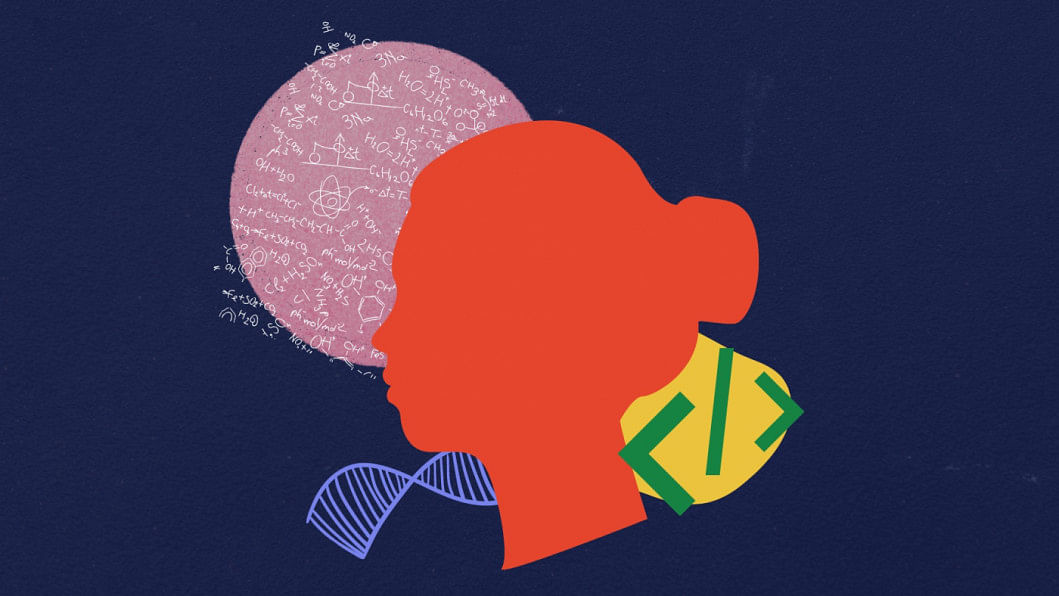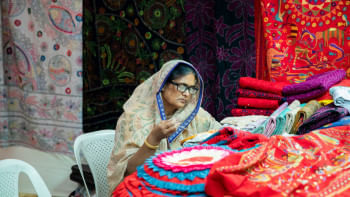Using innovation and technology for gender equality

The Covid-19 pandemic has accelerated a global digital and data-driven transformation, with digital technologies now being leveraged for work, leisure, and learning. Digital literacy has become almost as important as traditional literacy. As we move towards the Fourth Industrial Revolution (4IR) – defined by the increasing use of automation and artificial intelligence – digital skills have never been as prized as now. However, in many parts of the world, including Bangladesh, the digital revolution has left behind a critical part of society: our women and girls.
While Bangladesh has made remarkable progress in increasing access to digital technology for women and girls, a persistent gender-based digital divide has left many unable to reap the benefits of digitalisation. According to the 2020 GSMA report on mobile gender gap, women in Bangladesh are 29 percent less likely than men to own a mobile phone and 52 percent less likely than men to use mobile internet. Especially rural women, compared to their urban counterparts, find themselves more disenfranchised from technology – limiting their access to information, digital services, and opportunities. And when women and girls are connected to the digital world, many find themselves exposed to cyber violence that deters them from digital participation in political, social, and cultural life.
According to UN Women's 2022 Gender Snapshot, women's exclusion from the digital world has caused a loss of $1 trillion for the economies of developing countries in the last decade – a loss that will increase by 50 percent by 2025 if nothing is done in this regard. Besides economic benefits, enhancing women's safe and equal access to digital technologies offers immense opportunities to address development and humanitarian challenges and spark innovative and creative solutions that meet women's needs and promote their empowerment.
Women's participation in the digital sphere is therefore not just a matter of gender equality – it is a prerequisite for sustainable development. And as the country moves towards "Smart Bangladesh" by 2041, as envisioned by the government, this vision cannot be achieved without women and girls playing active roles.
So, how can we harness the transformative potential of digital technology for women and girls in Bangladesh, while mitigating the potentially harmful risks associated with its use?
This year's International Women's Day, under the theme "DigitALL: Innovation and Technology for Gender Equality," serves as an important reminder of the immense potential that digital transformation holds for accelerating gender equality and women's empowerment, but also the risk it bears for repeating and amplifying existing patterns of gender inequality. As the world is evolving to become more digital, we must ensure we can keep up the pace and unleash the potential of women and girls to become active agents of change in this transformation. Digital technologies need to be used to accelerate progress on the Sustainable Development Goals (SDGs) and gender equality, not to set us further back. A "Smart Bangladesh" with women and girls at the centre will help us eliminate the digital gender divide, not only in Bangladesh but worldwide, given the cross-border nature of digital transformation.
As a starting point, we must make greater and more sustained investments in increasing women and girls' digital literacy and familiarity with technology. This will enable them to participate effectively in the digital economy and gain access to digital services such as education, healthcare, and online banking. E-commerce and technology-based businesses offer women more flexibility, helping them to manage both paid and unpaid work, which is essential for economic empowerment. The United Nations Development Programme (UNDP) has been working with the government and our partners to develop and implement innovative solutions that can bridge the gender digital divide in Bangladesh. For example, our Aspire to Innovate (a2i) initiative is providing training on digital literacy to thousands of female entrepreneurs, and through our teacher's portal, more than 200,000 female teachers now have access to high-quality online educational materials. We have also utilised digital technology to launch Anondomela, an online marketplace that enables women entrepreneurs to access new markets.
However, basic skills will not be sufficient: we must also promote women and girls in the ICT sector by developing their skills in areas such as coding, where they are still critically underrepresented. Together with the government and our partners, we provide ICT training to women to bring them into the country's IT sector. By enhancing their digital skills and presenting them with female role models, we can also increase their opportunities to pursue careers in science, technology, engineering, and mathematics (STEM) – a field that reportedly 75 percent of jobs will relate to by 2050. This will require concerted efforts by the government, academia, civil society and, crucially, the private sector.
Critically, women also need to be involved in the creation of and decision-making around digital technology. We must ensure that today's emerging data-driven solutions do not perpetuate harmful gender stereotypes and patterns of discrimination. Online content and technology need to be developed with and for women and girls in a way that responds to their specific needs and priorities within a regulatory framework that prioritises, protects, and promotes the human rights of women and girls.
And lastly, we must make online spaces safe for women and girls. According to a 2022 survey by ActionAid, almost 64 percent out of 359 surveyed women in Bangladesh reported having faced cyber violence. Unfortunately, cyber harassment and violence against women and girls are often not taken seriously, deterring them from using the internet and threatening their online freedom of expression. We must tackle the harmful social norms at the root of these acts of violence and set up legal and policy frameworks that educate and protect girls and women from cybercrimes. Besides helping women and girls to recognise, report, and recover from online abuse, we must also intensify our civic education, work directly with the perpetrators, often boys and men, to uproot harmful social norms and power dynamics that underlie their actions. UNDP has been working to reduce the adverse effects of cyberbullying by creating peer support networks, offering free digital security courses that aim to make the digital space safer for women and girls and extending technical support to the Bangladesh police for strengthening cybercrime investigations.
This year's International Women's Day, under the theme "DigitALL: Innovation and Technology for Gender Equality," serves as an important reminder of the immense potential that digital transformation holds for accelerating gender equality and women's empowerment, but also the risk it bears for repeating and amplifying existing patterns of gender inequality.
As the world is evolving to become more digital, we must ensure we can keep up the pace and unleash the potential of women and girls to become active agents of change in this transformation. Digital technologies need to be used to accelerate progress on the Sustainable Development Goals (SDGs) and gender equality, not to set us further back. A "Smart Bangladesh" with women and girls at the centre will help us eliminate the digital gender divide, not only in Bangladesh but worldwide, given the cross-border nature of digital transformation. To this end, UNDP, together with the United Nations family, remains a committed partner of Bangladesh in harnessing digital technology and innovation to advance gender equality and sustainable development for all.
Stefan Liller is resident representative of the United Nations Development Programme (UNDP) in Bangladesh.

 For all latest news, follow The Daily Star's Google News channel.
For all latest news, follow The Daily Star's Google News channel. 










Comments